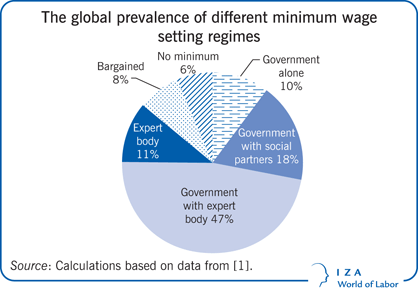Elevator pitch
The minimum wage has never been as high on the political agenda as it is today, with politicians in Germany, the UK, the US, and other OECD countries calling for substantial increases in the rate. One reason for the rising interest is the growing consensus among economists and policymakers that minimum wages, set at the right level, may help low-paid workers without harming employment prospects. But how should countries set their minimum wage rate? The processes that countries use to set their minimum wage rate and structure differ greatly, as do the methods for adjusting it. The different approaches have merits and shortcomings.

Key findings
Pros
- Of the numerous methods to set minimum wages, many countries now rely on an expert body to advise governments on the appropriate rate.
- Minimum wage setting regimes involving an expert body independent from governments can help to build support among employer and employee groups.
- The "bite" of the minimum wage--the ratio of the minimum to the median wage--varies substantially across countries.
- Minimum wages that vary for different groups of workers (such as by age and sector) can target low wages and poverty better than a simpler rate structure can.
Cons
- Using a formula to set the minimum wage leaves little flexibility to respond to changing labor market conditions.
- When the minimum wage is set by the government rather than by a formula or with the advice of a third party, there is a risk of setting it on political rather than economic grounds.
- Minimum wage rates that vary for different groups of workers can be too complex to administer and may lead to non-compliance because of ignorance about the correct rate.
- Comparable evidence on the effectiveness of different approaches is almost impossible to obtain, and many influences other than the minimum wage are at play.
Author's main message
The minimum wage has become an accepted way to tackle the extremes of low pay in many countries, but there is considerable variability in the way minimum wages are set around the world. Methods include formulas, government rate setting, union-bargained rates, and rates recommended by an expert body. Expert bodies whose recommendations are informed by a strong evidence base have the advantage that they can respond to changing economic conditions and build consensus among businesses and workers without political interference. The UK Low Pay Commission is an example of this approach, now emulated by many countries.
This article first appeared on IZA World of Labor in November 2015. Reproduced with permission


